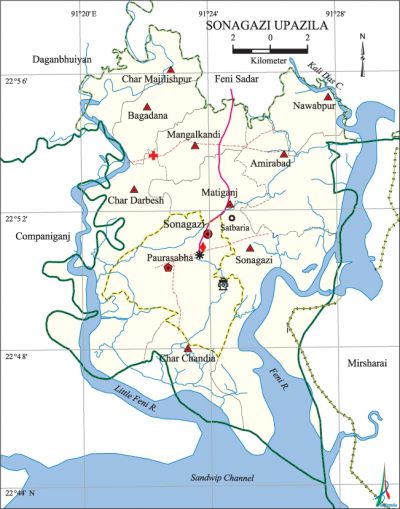Sonagazi Upazila
Sonagazi Upazila (feni district) area 235.07 sq km, located in between 22°44' and 22°58' north latitudes and in between 91°19' and 91°28' east longitudes. It is bounded by feni sadar upazila on the north, companiganj (noakhali) upazila on the south, mirsharai upazila on the east, Companiganj and daganbhuiyan upazilas on the west.
Population Total 235229; male 115680, female 119549; Muslim 218183, Hindu 16884, Buddhist 12, Christian 131 and others 19. Indigenous community such as tripura belongs to this upazila.
Water bodies Main rivers: feni, little feni; Kali Das Canal is notable.
Administration Sonagazi Thana was formed in 1920 and it was turned into an upazila in 1983.
| Upazila | ||||||||
| Municipality | Union | Mouza | Village | Population | Density (per sq km) | Literacy rate (%) | ||
| Urban | Rural | Urban | Rural | |||||
|
- |
9 |
94 |
95 |
12249 |
222980 |
1001 |
53.2 |
47.7 |
| Upazila Town | ||||||||
|
Area (sq km) |
Mouza |
Population |
Density (per sq km) |
Literacy rate (%) | ||||
|
4.97 |
3 |
12249 |
2465 |
53.19 | ||||
| Union | ||||
| Name of union and GO code | Area (acre) | Population | Literacy rate (%) | |
| Male | Female | |||
|
Amirabad 9 |
10241 |
14234 |
14155 |
47.21 |
|
Char Chandia 28 |
10642 |
19496 |
19896 |
44.73 |
|
Char Darbesh 38 |
10161 |
14064 |
14073 |
43.45 |
|
Char Majlishpur 47 |
3981 |
11987 |
13000 |
47.13 |
|
Nawabpur 76 |
2704 |
8955 |
9184 |
59.23 |
|
Bagadana 19 |
3056 |
10628 |
11693 |
43.28 |
|
Mangalkandi 57 |
3156 |
9250 |
9954 |
54.47 |
|
Matiganj 66 |
3362 |
11957 |
12551 |
53.22 |
|
Sonagazi 85 |
10786 |
15109 |
15043 |
45.78 |
Source Bangladesh Population Census 2001, Bangladesh Bureau of Statistics.

History of the War of Liberation On 28 July 1971, an encounter was held between the freedom fighters and the Pak army at Nawabpur in which Pak military commander Gul Mohammad was killed. On 15 August, 50 Pak soldiers were killed by mine explosion (planted by the freedom fighters) at a place adjacent to the Satbaria Bridge. In retaliation, the Pak soldiers killed 5 innocent persons of Baksha Ali, Sujapur Dasgram; the Pak army also conducted plundering and set many houses of the area on fire.
Marks of the War of Liberation Memorial monument 8.
Religious institutions Mosque 276, temple 3.
Literacy rate and educational institutions Average literacy 47.99%; male 51.36%, female 44.84%. Educational institutions: college 2, secondary school 20, primary school 93, community school 6, kindergarten 8, madrasa 10. Noted educational institutions: Sonagazi' Government College (1972), Mangalkandi High School (1912), Nawabpur High School (1923), Amirabad BC Laha High School (1917), Bishnupur High School (1925), Sonagazi Girls' High School, Baktermunshi Fazil Madrasa (1910), Sonagazi Fazil Madrasa (1918), Islamia Senior Madrasa (1930).
Newspapers and periodicals Upakul.
Cultural organisations Library 2, club 30, women's organisation 14, playground 20.
Main sources of income Agriculture 36.40%, non-agricultural labourer 3.35%, industry 1.58%, commerce 12.67%, transport and communication 4.40%, service 15.62%, construction 2.11%, religious service 0.56%, rent and remittance 14.04% and others 9.27%.
Main crops Paddy, wheat, potato, pulse, mustard, vegetables.
Extinct or nearly extinct crops Jute, sesame, linseed, arahar, aus paddy.
Main fruits Mango, blackberry, jackfruit, papaya, banana.
Fisheries, dairies and poultries Fishery 7, dairy 21, poultry 10, artificial cattle breeding centre 1.
Communication facilities Pucca road 55 km, semi-pucca road 20 km, mud road 120 km; waterway 22 nautical miles.
Extinct or nearly extinct traditional transport Palanquin, horse carriage, bullock cart.
Noted manufactories Bidi factory, welding factory.
Cottage industries Goldsmith, blacksmith, potteries, weaving, wood work, tailoring, bamboo work.
Hats, bazars and fairs Hats and bazars are 27, fairs 2, most noted of which are Baktermunshi Hat, Kazir Hat, Kutir Hat, Amir Uddin Munshi Hat, Mangalkandi Hat, Sonagazi Bazar, Bhor Bazar, Olama Bazar, Matiganj Bazar, Sonagazi' Mela and Dasher Hat Mela.
Main exports Banana, papaya, vegetables, fish.
Access to electricity All the unions of the upazila are under rural electrification net-work. However 24.02% (urban 51.57% and rural 22.54%) of the dwelling households have access to electricity.
Sources of drinking water Tube-well 84.64%, tap 0.82%, pond 5.81% and others 8.73%.
Sanitation 59.31% (rural 58.40% and urban 76.24%) of dwelling households of the upazila use sanitary latrines and 25.78% (rural 26.20% and urban 18.11%) of dwelling households use non-sanitary latrines; 14.91% (rural 5.66% and urban 15.41%) of households do not have latrine facilities.
Health centres Upazila health complex 1, family planning centre 8, satellite clinic 5, clinic 2.
Natural disasters Many people were victims of the devastating cyclones and tidal bore of 1876, 1961, 1985 and 1991; besides, these natural disasters also caused heavy damages to settlements, live stock and other properties of the upazila.
NGO activities Operationally important NGOs are brac, proshika, asa, Swanirvar Bangladesh. [Mahiuddin Hossain Mahin]
References Bangladesh Population Census 2001, Bangladesh Bureau of Statistics; Cultural survey report of Sonagazi Upazila 2007.
